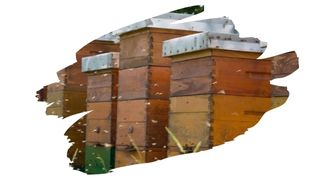Using a natural wood finish gives you the piece of mind of knowing that no chemicals are coating your beehive. But, the best types of exterior wood sealers are almost always made from synthetic ingredients.
So, is there a wholly natural wood finish that can truly weatherproof your beehive?
Well, in this post, we reveal which kind of weatherproofing wood sealers are best suited for exterior wooden surfaces. You will also learn what types of natural wood finishes can be used outside.
And keep reading to find out why a homemade blend may be the best natural finish for your beehive.

This post may contain affiliate links to products that we receive a commission for (at no additional cost to you). Learn more here.
What Kind Of Wood Sealer Should You Coat The Outside Of A Beehive With?
When it comes to outdoor wooden structures, they’ll often need an exterior wood finish or sealer.
This is because, (between the wind, rain, and sunshine), wood can quickly weather under the elements. And most interior wood finishes will wash off, (or start to mold), due to humidity and moisture.
So synthetic sealers made from urethane, (such as Spar Varnish), tend to be the go-to finishes for outdoor structures.
Nevertheless, it’s worth noting, that only the outside of a beehive needs a finish. So, always leave the inside of a beehive bare and free of any kind of finish, sealer or treatments.
But Are Synthetic Wood Sealers Safe To Have Around My Bees?
Well, after a wood sealer has finished drying and curing, it’s no longer doing something called ‘off-gassing’. Off-gassing refers to the fumes, (known as VOC’s or ‘Volatile Organic Compounds’), released off of finishes and paints.
And those fumes are often dangerous for humans, animals, and bees, to be around.
But, once a wood finish, paint or sealer, has stopped off-gassing, it is safe enough for bees to have indirect contact with. In other words, these finishes are safe for the outside of the beehive — but they should not coat the interior.
And What Do You Mean When You Say A Wood Sealer Is ‘Curing’?
Well, when we say that a wood sealer is ‘dry’ we are referring to an evaporation process.
The drying process can take a few days to complete. And once done, this turns a wet liquid finish into a fairly firm film that’s dry to the touch.
However, when a wood finish is ‘cured’, we are referring to a chemical reaction. And this process often takes a lot longer than drying.
In some cases, such as with Linseed oil or Tung oil, it can take weeks for these finishes to cure. However, once that chemical reaction is complete, it changes that finish from a firm film into a durable coat.
Are There Any Durable Natural Exterior Wood Finishes Or Sealers?
To be perfectly honest, no there are not.
Natural wood finishes aren’t the most waterproof or weatherproof. And that is mostly because they do not contain the chemical additives needed to ward off weathering and mold.
Even wholly natural finishes that can be used outside, (such as Tung oil), will need to be reapplied frequently. Especially since they’ll wear off quickly.
However, if your beehive is made from rot-resistant lumber (such as Cedar), then a natural finish can help some.
Can You Use Raw Linseed Oil To Seal The Wood On Beehives?
Raw Linseed oil is a poor choice for coating exterior wooden structures, such as a beehive. And that’s because of this wood finishes susceptibility to mold.
Raw Linseed oil is a natural oil finish extracted from flaxseed’s — so it is bee-safe. However, Linseed oil takes forever to cure…and therein lies the problem.
You see, it takes just 2-3 days for Linseed oil to dry. But, it can take up to 10 weeks for it to completely cure all the way through.
And, while it is still in the process of curing, mold will happily grow on this food-sourced wood finish.
Related Post: Is Linseed Oil Food Safe Enough To Use On A Cutting Board?
What About Boiled Linseed Oil?
Raw Linseed oil is a wholly natural wood finish in it’s purest form. However, Boiled Linseed oil is not a natural oil, since it is a chemically-enhanced derivative of Raw Linseed oil.
Boiled Linseed oil is made by putting Raw Linseed oil through a high-heat treatment. This treatment also involves adding chemical dryers — such as thinners and mineral spirits — to that boiling oil.
Those dryers help Boiled Linseed oil (BLO) cure in a fraction of the time of its Raw Linseed counterpart. Which is why BLO can be used to coat exterior timber.
However, if you want a completely natural finish, then you should avoid using Boiled Linseed oil.
Related Post: Boiled Linseed Oil vs Thompson’s Water Seal: Which One Is Better For Wood?
OK…So What Natural Wood Finish Can I Use Instead?
You can use wood wax. Often made from Beeswax, this wood finish is water-repellent and non-toxic.
And, because it is made from beeswax, bees have little issue with this substance coating their hive.
Are All Wood Waxes Made From Beeswax?
Not always. But, beeswax is one of the two most popular substances used to make this wood finish.
The other substance, used to make wood waxes, is Carnauba wax. Carnauba wax, (also known as Palm wax), is sourced from the Carnauba Palm tree, which grows around parts of Brazil.
Related Post: 7 Surprising Advantages (And 6 Disadvantages) Of Wax Finishes On Wood
And Will Wood Wax Waterproof My Beehive?
No it won’t. However, your hive will be much more water-repellent with it, than without.
But, as is the case with all natural wood finishes, this is not the best exterior wood sealant. Especially as it can become water-damaged if enough moisture, rainwater, or humidity gets into it.
So Why Bother With A Wood Wax Finish Then?
Well, because it makes wood look fantastic. And it provides a water-repelling top coat finish that doesn’t scratch as easily as most others.
It’s also great at keeping dirt out, as a wood wax finish will sit on the surface, and repel grit and grime.
However, wax alone will simply sit on the surface of wood. It won’t penetrate and coat the wood fibers underneath the surface of that timber.
So, if you want to use a wholly natural finish on exterior timber, then use something like Hard Wax Oil.
And What Is Hard Wax Oil?
Hard wax oil, (sometimes called Wood Butter), is a blend of wood wax and oil finishes.
That combination means that this viscous wax will penetrate wood, sinking below the surface into the grain. And at the same time, it will form a thick coat sat on the surface of wood too.
This adds up to a wood finish that is greater than it’s separate parts, because:
- Hard wax oil makes the penetrating oil finish more durable.
- And, at the same time, it allows wood wax to protect both above and below the surface of wood.
Their combination also makes for a more water-resistant wood finish too. Nevertheless, it’s still not going to be as waterproof as a synthetic exterior wood sealer.
And How Do You Make A Hard Wax Oil Finish?
Hard wax oils are made by blending natural wax (Beeswax or Carnauba wax) with natural oils (Linseed or Tung oil).
In fact, you can make your own Hard Wax oil recipe. And a mixture of 1/3rd wax plus 2/3rd oil, makes for a fantastic hard wax oil finish.
If this sounds good to you, then here’s an extra tip; blend beeswax with Tung oil (not Linseed oil) for a smooth finish. But, make sure that the Tung oil you use is made from pure 100% Tung oil.
What Is Tung Oil? Is It Natural?
Yes it is. Tung oil is extracted from the seeds of the Tung tree. And in its pure Tung oil wood finish form, it does not contain any chemical additives.
But, a lot of the Tung oil products sold at stores are not actually pure Tung oil. Some of them don’t even contain any Tung oil at all.
Instead, these so-called Tung oil finishes are made up of Tung oil mixed with solvents, and other chemicals.
And there’s no industry standard to these ‘Tung oil’ finishes either. So, one Tung oil finish can be very different from another.
Which is why you should always make sure you use pure Tung oil, such as Liberon’s Premium Pure Tung Oil.
Liberon’s 100% pure Tung oil will blend fantastically with wood wax. And you can find out more about Liberon’s Tung oil over on their website here.
So You Can Mix Tung Oil With Beeswax?
Absolutely! Hard Wax Oils made from Tung oil and beeswax make for a kind of thick paste. Think of smooth peanut butter, and you have the right idea about the consistency of this recipe.
But, it is not sticky to the touch. Instead the oil will make that wax much softer, soft enough to rub down into the surface of raw timber.
To Wrap Up, Here Are The 3 Key Takeaways From This Post…
- 1). Exterior wood should ideally be coated with an exterior wood sealer or finish.
- 2). Most natural wood finishes are best suited for interior wooden surfaces.
- 3). A Hard Wax oil finish – blending beeswax and pure natural Tung oil — can give outdoor wooden beehives some additional protection.



